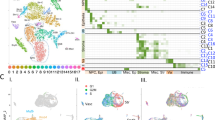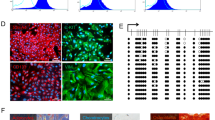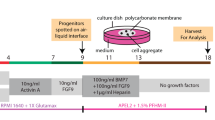Abstract
Present models suggest that the fate of the kidney epithelial progenitors is solely regulated by signals from the adjacent ureteric bud. The bud provides signals that regulate the survival, renewal and differentiation of these cells. Recent data suggest that Wnt9b, a ureteric-bud-derived factor, is sufficient for both progenitor cell renewal and differentiation. How the same molecule induces two seemingly contradictory processes is unknown. Here, we show that signals from the stromal fibroblasts cooperate with Wnt9b to promote differentiation of the progenitors. The atypical cadherin Fat4 encodes at least part of this stromal signal. Our data support a model whereby proper kidney size and function is regulated by balancing opposing signals from the ureteric bud and stroma to promote renewal and differentiation of the nephron progenitors.
This is a preview of subscription content, access via your institution
Access options
Subscribe to this journal
Receive 12 print issues and online access
$209.00 per year
only $17.42 per issue
Buy this article
- Purchase on Springer Link
- Instant access to full article PDF
Prices may be subject to local taxes which are calculated during checkout








Similar content being viewed by others
Change history
29 August 2013
In the version of this Article originally published, there was an error in Fig. 4a. The labels "Yap siRNA" and "Taz siRNA" were switched. This has been corrected in the PDF and HTML versions of the Article.
References
Grobstein, C. Inductive interaction in the development of the mouse metanephros. J. Exp. Zool. 130, 319–340 (1955).
Grobstein, C. Inductive epithlio-mesenchymal interaction in cultured organ rudiments of the mouse metanephros. Science 118, 52–55 (1953).
Carroll, T. J., Park, J. S., Hayashi, S., Majumdar, A. & McMahon, A. P. Wnt9b plays a central role in the regulation of mesenchymal to epithelial transitions underlying organogenesis of the mammalian urogenital system. Dev. Cell 9, 283–292 (2005).
Karner, C. M. et al. Canonical Wnt9b signaling balances progenitor cell expansion and differentiation during kidney development. Development 138, 1247–1257 (2011).
Hatini, V., Huh, S. O., Herzlinger, D., Soares, V. C. & Lai, E. Essential role of stromal mesenchyme in kidney morphogenesis revealed by targeted disruption of Winged Helix transcription factor BF-2. Genes Dev. 10, 1467–1478 (1996).
Levinson, R. S. et al. Foxd1-dependent signals control cellularity in the renal capsule, a structure required for normal renal development. Development 132, 529–539 (2005).
Voehringer, D., Liang, H. E. & Locksley, R. M. Homeostasis and effector function of lymphopenia-induced ‘memory-like’ T cells in constitutively T cell-depleted mice. J. Immunol. 180, 4742–4753 (2008).
Yu, J. et al. A Wnt7b-dependent pathway regulates the orientation of epithelial cell division and establishes the cortico-medullary axis of the mammalian kidney. Development 136, 161–171 (2009).
Yoshino, K. et al. Secreted Frizzled-related proteins can regulate metanephric development. Mech. Dev. 102, 45–55 (2001).
Lescher, B., Haenig, B. & Kispert, A. sFRP-2 is a target of the Wnt-4signaling pathway in the developing metanephric kidney. Dev. Dyn. 213, 440–451 (1998).
Karner, C. M. et al. Tankyrase is necessary for canonical Wnt signaling during kidney development. Dev. Dyn. 239, 2014–2023 (2010).
Chen, B. et al. Small molecule-mediated disruption of Wnt-dependent signaling in tissue regeneration and cancer. Nat. Chem. Biol. 5, 100–107 (2009).
Heallen, T. et al. Hippo pathway inhibits Wnt signaling to restrain cardiomyocyte proliferation and heart size. Science 332, 458–461 (2011).
Varelas, X. et al. The Hippo pathway regulates Wnt/ β-catenin signaling. Dev. Cell 18, 579–591 (2010).
Imajo, M., Miyatake, K., Iimura, A., Miyamoto, A. & Nishida, E. A molecular mechanism that links Hippo signalling to the inhibition of Wnt/ β-catenin signalling. EMBO J. 31, 1109–1122 (2012).
Xin, M. et al. Regulation of insulin-like growth factor signaling by Yapgoverns cardiomyocyte proliferation and embryonic heart size. Sci. Signal. 4, ra70 (2011).
Reddy, B. V. & Irvine, K. D. The Fat and Warts signaling pathways: new insights into their regulation, mechanism and conservation. Development 135, 2827–2838 (2008).
Zhang, J., Smolen, G. A. & Haber, D. A. Negative regulation of YAP by LATS1 underscores evolutionary conservation of the Drosophila Hippo pathway. Cancer Res. 68, 2789–2794 (2008).
Halder, G. & Johnson, R. L. Hippo signaling: growth control and beyond. Development 138, 9–22 (2011).
Lu, L. et al. Hippo signaling is a potent in vivo growth and tumor suppressor pathway in the mammalian liver. Proc. Natl Acad. Sci. USA 107, 1437–1442 (2010).
Tanigawa, S. et al. Wnt4 induces nephronic tubules in metanephric mesenchyme by a non-canonical mechanism. Dev. Biol. 352, 58–69 (2011).
Blank, U., Brown, A., Adams, D. C., Karolak, M. J. & Oxburgh, L. BMP7 promotes proliferation of nephron progenitor cells via a JNK-dependent mechanism. Development 136, 3557–3566 (2009).
Willecke, M. et al. The fat cadherin acts through the hippo tumor-suppressor pathway to regulate tissue size. Curr. Biol. 16, 2090–2100 (2006).
Rock, R., Schrauth, S. & Gessler, M. Expression of mouse dchs1, fjx1, and fat-j suggests conservation of the planar cell polarity pathway identified in Drosophila. Dev. Dyn. 234, 747–755 (2005).
Mao, Y. et al. Characterization of a Dchs1 mutant mouse reveals requirements for Dchs1-Fat4 signaling during mammalian development. Development 138, 947–957 (2011).
Saburi, S. et al. Loss of Fat4 disrupts PCP signaling and oriented cell division and leads to cystic kidney disease. Nat. Genet. 40, 1010–1015 (2008).
Karner, C. M. et al. Wnt9b signaling regulates planar cell polarity and kidney tubule morphogenesis. Nat. Genet. 41, 793–799 (2009).
Yallowitz, A. R., Hrycaj, S. M., Short, K. M., Smyth, I. M. & Wellik, D. M. Hox10 genes function in kidney development in the differentiation and integration of the cortical stroma. PLoS One 6, e23410 (2011).
Mendelsohn, C., Batourina, E., Fung, S., Gilbert, T. & Dodd, J. Stromal cells mediate retinoid-dependent functions essential for renal development. Development 126, 1139–1148 (1999).
Tufro, A., Norwood, V. F., Carey, R. M. & Gomez, R. A. Vascular endothelial growth factor induces nephrogenesis and vasculogenesis. J. Am. Soc. Nephrol. 10, 2125–2134 (1999).
Brunskill, E. W., Lai, H. L., Jamison, D. C., Potter, S. S. & Patterson, L. T. Microarrays and RNA-Seq identify molecular mechanisms driving the end of nephron production. BMC Dev. Biol. 11, 15 (2011).
Hoch, R. V. & Soriano, P. Context-specific requirements for Fgfr1 signalingthrough Frs2 and Frs3 during mouse development. Development 133, 663–673 (2006).
Rodriguez, C. I. et al. High-efficiency deleter mice show that FLPe is an alternative to Cre-loxP. Nat. Genet. 25, 139–140 (2000).
Acknowledgements
We thank Y. Yang (NIH, USA) for providing the Vangl2 mutant mice, M. Takeichi (RIKEN Center for Developmental Biology, Japan) for providing the Fat4 full-length and ECD plasmids, J. Cabera for artwork and O. Cleaver, Q. Li and D. Marciano for reading and commenting on the manuscript. This work was supported by a post-doctoral fellowship from the A.H.A. to A.D. and from the Japanese Society for the Promotion of Science to S.T., the NIH (R01DK080004 and R01DK095057 to T.C.) and National Cancer Institute’s Center for Cancer Research (A.P.). This work was supported by the George O’Brien Kidney Research Center at UTSW.
Author information
Authors and Affiliations
Contributions
Experiments were designed by A.D., S.T., C.M.K., A.O.P. and T.J.C. Experiments were performed by A.D., S.T. and C.M.K. Data were interpreted by A.D., S.T., C.M.K., A.O.P. and T.J.C. M.X., L.L., C.C. and E.N.O. provided mice or other reagents. The paper was written by A.D., S.T., A.O.P. and T.J.C.
Corresponding author
Ethics declarations
Competing interests
The authors declare no competing financial interests.
Integrated supplementary information
Supplementary Figure 1 Characterization of the stromaless mutants
Panel A: Ablation of the stroma in the Foxd1cre; Rosa26DTA mutant kidneys. Comparison of stromal markers in wildtype (A, C, E) and Foxd1Cre;Rosa26DTA (B, D, F) kidneys at e15.5 (A-D) and 18.5 (E, F). At E15.5, the stromal expression of Foxd1 (green in A and B) cortical to the progenitor cells is lost (arrows in A and B.). Meis1/2 (green in C–F) is decreased in mutants at E15.5 (arrow in D) and completely lost by E18.5 (arrow in F). All sections are co-stained with the progenitor marker Six2 (red) and the UB marker cytokeratin (blue in A-D) or the lectin Dolichous biflorus agglutinin (DBA. White in E, F). In A and B, the cortex of the kidney is up and the medulla is down. In C–F, cortex is to the left, the medulla is to the right. Scale bar = 50 microns. Panel B: Ablation of the stroma affects the activation of distinct classes of Wnt9b target genes in the nephron progenitors. In situ hybridization on sections of E15.5 wildtype (A, C, E, G) and FoxdCre;Rosa26DTA (B, D, F, H) kidneys hybridized with antisense probes to Class II/progenitor targets Tafa5 (A, B) and Pla2g7 (C,D) and Class I/PTA targets Pax8 (E,F) and C1qdc2 (G,H). Note: Expanded domain of Class II targets and significant reduction in Class I. All images captured at 20x magnification. Scale bar = 100 microns..
Supplementary Figure 2 Localization of YAP in vivo and in vitro.
Left panel: Low mag localization of total and phosphorylated Yap: E18.5 wild type (A, B) and Fat4 null (C) kidneys were subjected to immunostaining using YAP and pYAP antibodies (in green). All slides were co-stained with Six2 (red) and Cytokeratin (blue). Single channel images for pYap or Yap are shown in black and white below the corresponding color panel. In all panels, the cortex is up and medullary region is down. Arrowheads in A’ and B’ indicates cortical zone while the arrows indicate the medullary region. Scale bar = 100 microns. Right panel: Expression of YAP in cell cultures: Immunostaining of MM progenitor cells with anti-Yap antibody (green). YAP predominantly exhibits nuclear expression at low density and diffuse expression throughout the cell at higher density. Nuclei are co-stained with Dapi (blue). Scale bar: 20 microns.
Supplementary Figure 3 Kinetics of TAZ/YAP ablation from the progenitors.
Wildtype (A, C, E, G) and Six2Cre; Yapflox/flox;Tazflox/flox (B, D, F, H) kidneys from E11.5 (A, B), 12.5 (C,D), 13.5 (E, F) and 18.5 (G, H) embryos stained with antibodies to pYAP (green), Six2 (red) and Cytokeratin (CK, blue). Single channel images for pYap are shown in black and white to the right of the corresponding color panel. Note efficient ablation of pYap from the Six2 expressing domain by E13.5. Scale bars = 100 microns.
Supplementary Figure 4 Response of cultured progenitor cells to Wnt and Yap signaling.
Mesenchymal cells isolated from 20 embryos from 3 distinct mothers were cultured and subjected to QrtPCR to analyze Wnt9b target gene expression and Six2 after the following treatments: (A) transfection with an empty plasmid or a Lef1/beta-catenin fusion construct; (B) addition of IWP2 or IWR1 to the media for 48 hrs. Shown is one representative experiment analysed in triplicate PCR reactions. .
Supplementary Figure 5 Percent proliferation of Six2 positive progenitor cells in wild type, Fat4 and Six2Cre; Tazflox/flox;Yapflox/flox mutants.
Kidneys were co-stained with Six2, cytokeratin and pHH3. The number of Six2/pHH3 double positive cells was quantified for wildtype TAZ/YAP and Fat4 mutants. 10.5% (p = 0.004) of Six2 positive cells were PHH3 positive in the Six2cre; Tazflox/flox; YAPflox/flox mutants, 16% (p = 0.02) in Fat4 mutants and 13% in wild type. Data is the mean from 5 different kidneys for TAZ/YAP mutants (compared to 5 wildtype littermates) and 4 kidneys from Fat4 mutants (compared to 4 wildtype littermates). Statistics source data can be found in Table1. Error bars indicate SEM.
Supplementary Figure 6 Expression of Class I targets requires a Wnt ligand in wildtype, stromaless and Fat4 mutants.
A–F: In situ hybridization analyzing the expression of a Class I/PTA target C1qdc2 in kidney explants isolated from E11.5 wild type (A-B), Foxd1cre; Rosa26DTA (C-D) and Fat4 null (E-F) kidneys treated either with DMSO (A, C, E) or a Wnt ligand production inhibitor IWP2 (B, D, F).
Supplementary Figure 7 Expression of stromal and progenitor targets in various mutants.
Panel A: The stroma develops normally in Fat4 mutants. E13.5 (A, B, E, F, I, J, M, N) and 18.5 (C, D, G, H, K, L, O, P) wild type (A, C, E, G, I, K, M, O) and Fat4 null (B, D, F, H, J, L, N, P) kidney sections stained with the progenitor marker Six2 (red), the UB/collecting duct marker CK (blue) and the cortical stroma markers Foxd1 (green in A-D) and Meis 1/2 (green in E-H) and the medullary stroma markers Slug (green in I-L) and Lef1 (green in M-P). Panel B: Characterization of Class II/progenitor targets in Wnt9b/Vangl2 double mutants: E15.5 (A-D) and 18.5 (E-H) kidney sections from wild type (A,E), Wnt9b null (B), Wnt9b hypomorph (neo) (F), Vangl2lp/lp (C, G) and Wnt9b−/−; Vangl2lp/lp and Wnt9bneo/neo;Vangl2lp/lp mutants were subjected to immunostaining for progenitor genes Cited1 (green), Six2 (red) and the UB marker cytokeratin (blue). Panel C: pSmad1/5/8 expression remains unaltered in wild type and mutant kidneys: E18.5 wildtype (A,B), Six2Cre;Yapflox/flox;Tazflox/flox (C,D) and Fat4−/− (E, F) kidneys stained with antibodies to pSmad1/5/8 (green) and the collecting duct marker DBA (red). Images show the cortical regions (A, C, E) and the medullary region (B, D, F). There is no change in pSmad activity in Fat4 or Yap/Taz mutants relative to wildtype. Scale bar = 100 microns.
Supplementary Figure 8 Characterization of wildtype, Wnt9b, Fat4 and YAP/TAZ mutant kidneys.
A: Fate mapping of the nephron progenitors in Wnt9b null kidneys. The Six2 expressing progenitor cells were lineage traced in SixCre;RosaYap (a,c,e,g) and SixCre;RosaYap;Wnt9b−/− (b,d,f,h) kidneys by co-staining with antibodies to GFP (green) and the stromal proteins (in red) Foxd1 (a,b), Meis1/2 (c,d), Slug (e,f) and Lef1 (g,h). The ureteric bud epithelia was stained with anti-cytokeratin (blue) B: In situ hybridization using antisense riboprobes for Taz and Yap on Wildtype and Fat4 null kidneys at E18.5. C: Wildtype (A, E, I), Taz single (B, F, J), YAP single (C, G, K) and Taz and YAP double mutants (D, H, L) were analyzed for the expression of the following targets. ClassII/progenitor target Amphiphysin (in red), pYAP (in green) (A-D); Class II target Cited1 (in red) and GFP (in green, indicating Six2cre activity) (E-H); Class I/PTA target Pax8 (in purple) (I-L). The ureteric bud epithelia was stained with DBA (blue in A-H). Scale bar 100 microns.
Supplementary information
Supplementary Information
Supplementary Information (PDF 2403 kb)
Supplementary Table 1
Supplementary Information (XLS 30 kb)
Rights and permissions
About this article
Cite this article
Das, A., Tanigawa, S., Karner, C. et al. Stromal–epithelial crosstalk regulates kidney progenitor cell differentiation. Nat Cell Biol 15, 1035–1044 (2013). https://doi.org/10.1038/ncb2828
Received:
Accepted:
Published:
Issue Date:
DOI: https://doi.org/10.1038/ncb2828
This article is cited by
-
Generation of proximal tubule-enhanced kidney organoids from human pluripotent stem cells
Nature Protocols (2023)
-
Cep120 is essential for kidney stromal progenitor cell growth and differentiation
EMBO Reports (2023)
-
Determining lineage relationships in kidney development and disease
Nature Reviews Nephrology (2022)
-
Principles of human and mouse nephron development
Nature Reviews Nephrology (2022)
-
Regulation of nephron progenitor cell lifespan and nephron endowment
Nature Reviews Nephrology (2022)



